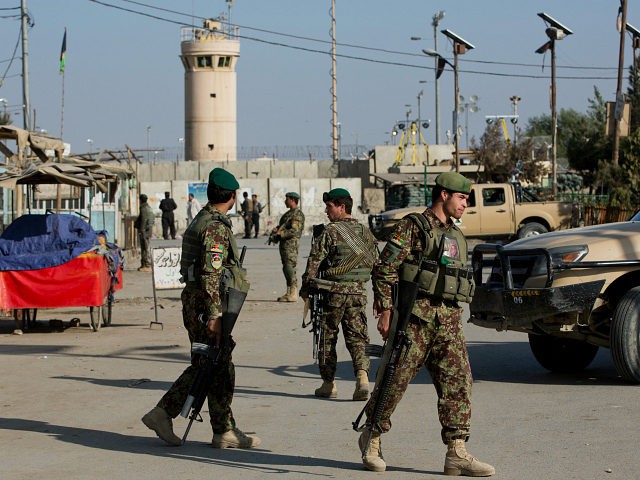Afghanistan’s intelligence agency, the National Directorate of Security (NDS), warned the U.S. military at least twice about a possible suicide assault by a Bagram airbase employee before an unprecedented attack inside the heavily-fortified facility left four Americans dead and 16 others wounded.
Although the assailant has been identified as a “former” Taliban jihadists, the terrorist group has taken responsibility for the attack at Bagram, America’s largest military facility in Afghanistan.
It is unclear whether the terrorist, identified as Qari Naib, had rejoined the Taliban or if he ever really abandoned the group.
Naib had already been accused of launching rockets at Bagram five years ago, but “authorities never found any evidence linking him to the crime, and his mother said he was innocent,” reports Reuters.
Citing Afghan government and security officials, the news agency adds that the U.S.-led forces repeatedly denied requests by Afghanistan for information on “suspicious” local employees.
Asked to comment on the claims, Capt. William Salvin, a spokesman for the NATO mission in Afghanistan, said coalition forces “routinely partner with ANDSF [Afghan National Defence and Security Forces] on all elements of security, to include information sharing.”
“We maintain a strong, day-to-day working relationship with our Afghan counterparts but due to operational security we do not get into specifics about what is shared,” he added.
Prior to being hired at the U.S. military base, Naib participated in an Afghan-led de-radicalization program that has been shut down. It was backed by the United States at a cost of $55 million to American taxpayers.
The Special Inspector General for Afghanistan Reconstruction (SIGAR), a U.S. watchdog agency, recently determined that armed violence and insecurity increased in Afghanistan under the effort, adding that it failed to achieve “significant diminishment of the military capacity of armed opposition.”
Nevertheless, the Afghan government plans to establish a successor to the de-radicalization program early next year.
Reuters learned from Afghan authorities that the Bagram terrorists had been using a fake name — Qari Enayat — while working for Texas-based Fluor Corp (FLR.N) as a car mechanic at the U.S. military facility.
Relatives revealed that the Taliban-linked assailant underwent “security checks, including fingerprints and biometrics to make sure he was not involved in past crimes,” notes Reuters.
Fluor Corp. revealed that the suicide bomber had been hired by one of its subcontractors.
“Fluor does not directly employ Afghans at Bagram,” the company told Reuters. “Furthermore, screening and vetting of employees follows a process prescribed by the U.S. government. We follow this process and require our subcontractors to do the same.”
On November 12, two U.S. Army soldiers and two American contractors died from injuries sustained from an improvised explosive device (IED), also known as a homemade bomb, detonated by Naib.
Besides the 16 U.S. troops, the attacker also wounded a Polish soldier participating in the U.S.-led mission.
Reuters acknowledges:
Many intelligence leads turn out to be false and it is not clear whether better coordination would have unearthed [the Bagram attacker’s] true intentions in time to prevent him killing two U.S. soldiers and two contractors and wounding at least 15 others, in one of the worst assaults on U.S. forces for years.
But the first attack inside one of NATO’s most secure bases has raised questions about Western forces’ screening of local workers and about program designed to reintegrate insurgents into society.
Citing Afghan authorities, Reuters notes that the U.S. military is currently sharing information with Afghanistan.
“After this attack, American forces have agreed to share that information about their Afghan workers with us,” Wahid Sediqqi, a spokesman for the governor of Parwan province, told Reuters.
The sprawling Bagram base is named after the Parwan district in northern Afghanistan that houses it.
Reuters notes that the “insider attack” at the base has “complicated” U.S.-backed ongoing operations against the Afghan Taliban, al-Qaeda, and the local Islamic State (ISIS/ISIL).
“Since the Bagram attack, the base has been in near-lockdown, with few Afghan workers now permitted inside,” it reports. “Only 200 of an estimated 3,000 Afghans are believed to be allowed to return to work for now, police in Bagram said.”
Although jihadists have targeted Bagram in the past, the November 12 attack marks the first time a suicide bomber made it inside.
“Bagram base, protected by concrete barriers and barbed wire fences and home to around 14,000 coalition soldiers and contractors, has come under attack before, mainly from rockets launched by militants outside, but never from within,” points out Reuters.

COMMENTS
Please let us know if you're having issues with commenting.